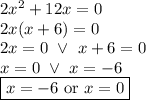2) solve. x2 – 5x – 6 = 0

Mathematics, 19.08.2019 14:30, aliviadushane
1) solve by using the perfect squares method. x2 + 8x + 16 = 0
2) solve. x2 – 5x – 6 = 0
3) what value should be added to the expression to create a perfect square? x2 – 20x
4) solve. x2 + 8x – 8 = 0
5) solve: 2x2 + 12x = 0
6) solve each problem by using the quadratic formula. write solutions in simplest radical form. 2x2 – 2x – 1 = 0
7) calculate the discriminant. x2 – x + 2 = 0
8) calculate the discriminant and use it to determine how many real-number roots the equation has. 3x2 – 6x + 1 = 0
9) without drawing the graph of the equation, determine how many points the parabola has in common with the x-axis and whether its vertex lies above, on, or below the x-axis. y = 2x2 + x – 3
10) without drawing the graph of the equation, determine how many points the parabola has in common with the x-axis and whether its vertex lies above, on, or below the x-axis. y = x2 – 12x + 12

Answers: 1
Other questions on the subject: Mathematics

Mathematics, 21.06.2019 16:20, amortegaa805
Which best explains why this triangle is or is not a right triangle?
Answers: 1


Mathematics, 21.06.2019 21:00, CoolDudeTrist
Construct the graph that models the given situation
Answers: 1

Mathematics, 21.06.2019 21:30, gonzalezashley152
In a test for esp (extrasensory perception), the experimenter looks at cards that are hidden from the subject. each card contains either a star, a circle, a wave, a cross or a square.(five shapes) as the experimenter looks at each of 20 cards in turn, the subject names the shape on the card. when the esp study described above discovers a subject whose performance appears to be better than guessing, the study continues at greater length. the experimenter looks at many cards bearing one of five shapes (star, square, circle, wave, and cross) in an order determined by random numbers. the subject cannot see the experimenter as he looks at each card in turn, in order to avoid any possible nonverbal clues. the answers of a subject who does not have esp should be independent observations, each with probability 1/5 of success. we record 1000 attempts. which of the following assumptions must be met in order to solve this problem? it's reasonable to assume normality 0.8(1000), 0.2(1000)%30 approximately normal 0.8(1000), 0.2(1000)% 10 approximately normal srs it is reasonable to assume the total number of cards is over 10,000 it is reasonable to assume the total number of cards is over 1000
Answers: 1
Do you know the correct answer?
1) solve by using the perfect squares method. x2 + 8x + 16 = 0
2) solve. x2 – 5x – 6 = 0
2) solve. x2 – 5x – 6 = 0
Questions in other subjects:



Biology, 29.01.2020 00:57


English, 29.01.2020 00:57




Biology, 29.01.2020 00:57

Mathematics, 29.01.2020 00:57
















